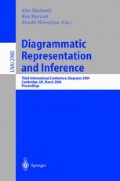Abstract
A potential educational advantage of animated diagrams over static depictions is their capacity to provide explicit external representation of temporal changes that occur in dynamic subject matter [1]. However, animations are not necessarily better for learners [2]. One possible reason is a mismatch between a specific animation’s presentational characteristics and a particular learner’s processing capacity [c.f. 3]. For example, if the animation’s playing speed is too high, the learner may miss some key aspects of the content. User control has been suggested as a possible way to address such mismatch problems [4]. The assumption here is that the learner regulates the animation’s playing regime in ways that present information relevant to the task at hand in an appropriate fashion. In the previous example, this would involve reducing the animation’s speed so that key aspects could be readily extracted. Current computer-based animation systems can provide users with extensive control over speed and various other characteristics of animations. Unfortunately, the provision of user control does not always result in the desired learning improvements [5].
Access this chapter
Tax calculation will be finalised at checkout
Purchases are for personal use only
Preview
Unable to display preview. Download preview PDF.
References
Lowe, R.K.: Extracting information from an animation during complex visual learning. European Journal of Psychology of Education 14, 225–244 (1999)
Tversky, B., Morrison, J.B., Bétrancourt, M.: Animation: Can it facilitate? International Journal of Human Computer Studies 57, 247–262 (2002)
Kaiser, M.K., Proffitt, D.R., Whelan, S.: Understanding wheel dynamics. Cognitive Psychology 22, 342–373 (1990)
Narayanan, N.H., Hegarty, M.: Multimedia design for communication of dynamic information. International Journal of Human-Computer Studies 57, 279–315 (2002)
Lowe, R.K.: Animation and learning: Selective processing of information in dynamic graphics. Learning and Instruction 13, 157–176 (2003)
Author information
Authors and Affiliations
Editor information
Editors and Affiliations
Rights and permissions
Copyright information
© 2004 Springer-Verlag Berlin Heidelberg
About this paper
Cite this paper
Lowe, R. (2004). User-Controllable Animated Diagrams: The Solution for Learning Dynamic Content?. In: Blackwell, A.F., Marriott, K., Shimojima, A. (eds) Diagrammatic Representation and Inference. Diagrams 2004. Lecture Notes in Computer Science(), vol 2980. Springer, Berlin, Heidelberg. https://doi.org/10.1007/978-3-540-25931-2_38
Download citation
DOI: https://doi.org/10.1007/978-3-540-25931-2_38
Publisher Name: Springer, Berlin, Heidelberg
Print ISBN: 978-3-540-21268-3
Online ISBN: 978-3-540-25931-2
eBook Packages: Springer Book Archive

